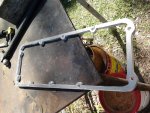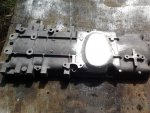It runs!!!!
Big grins tonight.
Not without it's teething problems, but she has fired up (eventually) and sounds mean! I only have the centre muffler on at the moment, and then the exhaust exits just past the rear axle. I have to fit the rear muffler, and sooner rather than later! The idle is perfectly smooth and when you open the throttle, the response is brutally instant!
Problems:
Still to do:
Again, I'm celebrating tonight!
Big grins tonight.
Not without it's teething problems, but she has fired up (eventually) and sounds mean! I only have the centre muffler on at the moment, and then the exhaust exits just past the rear axle. I have to fit the rear muffler, and sooner rather than later! The idle is perfectly smooth and when you open the throttle, the response is brutally instant!
Problems:
- Water leak where the temperature sender - easy fix.
- Water leak from heater core - harder fix, need to find another one.
- Oil leak from LH rocker cover. It seems that the tin cover cover does not have enough height to clear the rocker pedestals. I will try doubling up the rubber gaskets to see if that gives me the necessary clearance and a good seal.
- MAP sensor does not seem to be responding. More research required. Megasquirt is currently set to run in Alpha-N mode, so the MAP sensor is not required for now.
- Coolant temp and air temp readings are a bit haywire, I need to calibrate them.
Still to do:
- Wire in idle control valve.
- Finish instrumentation wiring.
- Convert from batch to semi-sequential ignition (components are on back-order).
Again, I'm celebrating tonight!









